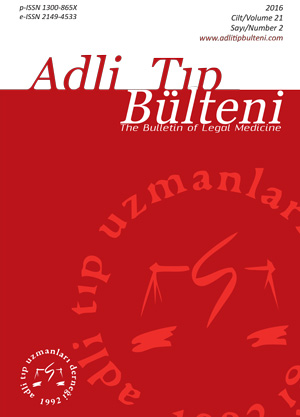Child Sexual Abuse Whom Trailing into the Crime of Sexual Assault A Case Report
DOI:
https://doi.org/10.17986/blm.2016220400Keywords:
crime, children’s rights, sexual abuseAbstract
Prisons are especially high-risk areas for children because sexual abuse is used for punishment in prisons. We aimed to draw attention to children’s rights by presenting a case of sexual abuse offender who became a sexual abuse victim while in prison because of this crime.
In the examination of a 10-year-old boy who was allegedly sexually abused by two people, there were infected fibrous bands, ecchymosis extending to the anus, anal deterioration of symmetry of pleats, mildly decreased anal tone and oval view of anus.
A 14-year-old boy was allegedly committed to sexual abuse crime and was arrested. He admitted to our hospital 9 days after the arrest. There were ecchymosis and abbresions on his body. He he claimed that he was beaten by the prisoners in the same ward. Two months later, the same boy admitted to our department and claimed that he was beaten in the toilet and underwent anal rape by putting a pen. There was no clue of beat or rape in the examination. In the psychiatric assessment, he was diagnosed as post traumatic stress disorder.
According to the The United Nations Convention on the Rights of the Child, rights of the children are protected by the state. Even in prisons, rights of the children should be protected.
In our case, the perpetrator and the victim could not be adequately protected children from sexual abuse, crime and prison environment that is ineffective in the prevention of crime suggests that contribute to prison again.
Key Words: Crime, Children’s rights, sexual abuseDownloads
References
Krug EG, Dahlberg LL, Mercy JA, Zwi AB, Lozano R. World report on violence and health [Internet]. Geneva, World Health Organization; 2002 [cited 2014 Jul 10]. Available from: http://www.who.int/violence_injury_prevention/violence/world_report/en/full_en.pdf?ua=1
WHO. Promoting research to prevent child maltreatment [Internet]. XIXth ISPCAN International Congress on Child Abuse and Neglect; 2012 [cited 2014 Jul 10]. Available from: http://www.who.int/violence_injury_prevention/violence/child/ispscan_report_june2013.pdf
Türkiye Büyük Millet Meclisi İnsan Haklarını İnceleme Komisyonu. Çocuk ve Gençlik Kapalı Ceza İnfaz Kurumları ve Eğitimevleri İnceleme Raporu [Internet]. [cited 2014 Jul 10]. Available from: http://www.tbmm.gov.tr/komisyon/insanhaklari/belge/cocuk_ve_genclik.pdf
Gölge ZB. Cinsel saldırı olgularının suç motivasyonuna göre sınıflandırılması. Adli Tıp Dergisi. 2007;21(2):11-19
Türkiye Büyük Millet Meclisi İnsan Haklarını İnceleme Komisyonu. Kişisel ve Siyasi Haklar Uluslararası Sözleşmesi [Internet]. [cited 2014 Jul 10]. Available from: http://www.tbmm.gov.tr/komisyon/insanhaklari/pdf01/53-73.pdf
UNICEF Türkiye. Çocuk Haklarına Dair Sözleşme [Internet]. [cited 2014 Jul 10]. Available from: http://www.unicef.org/turkey/crc/_cr23c.html
Kızmaz Z. Cezaevinin ve hapsetmenin suçu engellemedeki etkisi. Dumlupınar Üniversitesi Sosyal Bilimler Dergisi, 2007;17:44-69.
Foucault M (Çev: Kılıçbay MA). Hapishanenin Doğuşu. 3. Baskı. Ankara: İmge Kitabevi; 2006.
Foucault M (Çev: Ergüden I). İktidarın Gözü. Birinci Basım. İstanbul: Ayrıntı Yayınları; 2003.
Öztürk M, Demirdağ MA. Namusun gölgesinde yatmak: Mardin Cezaevi mahkûmlarının namus algısı üzerine bir araştırma. Suç Önleme Sempozyumu. 7-8 Ekim 2011, Bursa.
Tıraşçı Y, Gören S. Çocuk istismarı ve ihmali. Dicle Tıp Dergisi, 2007;34:70-74.
Isır AB, Büyükçelik A, Özdil S, Coşkun AG. Gaziantep Üniversitesi Tıp Fakültesi Adli Tıp Anabilim Dalına Yansıyan Cinsel İstismar Olgularının ve Bu Olgular İçinde Çocuk İstismarı ve Mental Retardasyonun Değerlendirilmesi. Bull Leg Med. 2009;14(1):5-11. https://doi.org/10.17986/blm.2009141683 DOI: https://doi.org/10.17986/blm.2009141683
Downloads
Published
Issue
Section
License
Copyright (c) 2016 Tülay Elbek- Özlem Erel- Musa Dirlik- Selim Özkök- Hatice Aksu- Füsun Çallak Kallem- Bedir Korkmaz- Ufuk Katkıcı

This work is licensed under a Creative Commons Attribution 4.0 International License.
The Journal and content of this website is licensed under the terms of the Creative Commons Attribution (CC BY) License. The Creative Commons Attribution License (CC BY) allows users to copy, distribute and transmit an article, adapt the article and make commercial use of the article. The CC BY license permits commercial and non-commercial re-use of an open access article, as long as the author is properly attributed.

